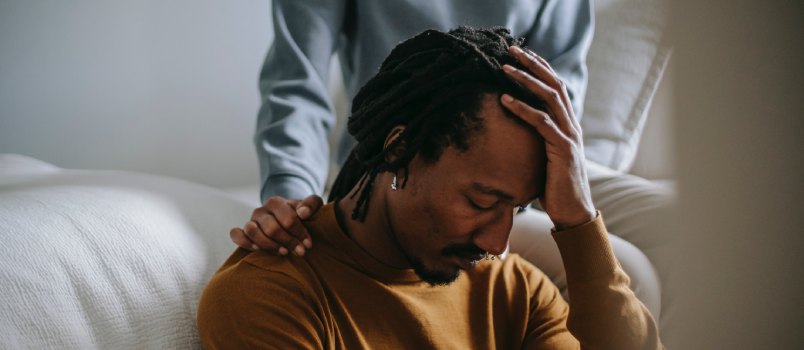9 Practical Ways to Heal Core Wounds in a Relationship

Unlock Daily 30-Sec Tips for a Happier Relationship
👉 Subscribe FREEKey Takeaways
Marriage.com AI Quick Summary
Relationships can leave deep marks, shaping the way someone connects, trusts, and loves. Sometimes, these marks run so deep that they feel impossible to mend.
Old arguments, unspoken pain, or unmet needs can create walls where there once was closeness. It is not always easy to pinpoint where it all began… but those moments of hurt, the ones that linger, often hold the key.
Healing core wounds is not about erasing the past—it is about understanding it, holding space for the pain, and finding ways to move forward with care. It takes effort from both sides and a willingness to listen and try again.
But even in the most challenging times, there is hope. Every relationship has its scars, yet it is in the healing that bonds grow stronger, deeper, and more meaningful. With patience and love, those wounds can become a source of connection rather than division.
What are core wounds?
Core wounds are deep, emotional pains that seem to stick with someone no matter how much time passes. They often stem from moments of hurt, rejection, or betrayal—whether in childhood, past relationships, or life’s difficult chapters.
These wounds can shape how people view themselves and others and even love themselves. It might feel like they hide under the surface, but they have a way of showing up—through fears, insecurities, or patterns that repeat.
One research study explored the lasting impact of childhood trauma on adults. Using a survey-based interview method, the study revealed that adverse childhood experiences can lead to patterns of victimhood thinking, hindering personal growth and well-being.
They whisper things like, “You are not enough,” or “What if they leave?”
It is not easy to face them… but understanding where they come from is the first step to breaking free and finding peace.
5 common types of core wounds
Core wounds often leave someone feeling stuck in cycles of pain and fear, shaping how they relate to themselves and others. These deep emotional scars can come from childhood, past relationships, or even life’s unexpected challenges.
Understanding the common types of core attachment wounds can be a powerful step toward healing and creating healthier connections.
1. Fear of abandonment
Such a wound stems from experiences of being left behind—whether emotionally or physically. It creates a deep fear that others will leave, even when there is no real sign of it happening.
Someone with this wound might cling to relationships or struggle with overwhelming anxiety. It can feel like a constant need for reassurance… but healing starts with building trust, both in others and in oneself.
2. Fear of rejection
Rejection can leave a lasting mark, making someone feel like they are not worthy of love or acceptance. This wound often creates patterns of avoiding vulnerability or pushing others away to avoid getting hurt.
It whispers harsh words like, “You are not good enough.” Overcoming this fear means learning to accept oneself fully and recognizing that rejection does not define one’s value.
3. Betrayal and broken trust
When trust is shattered, it can feel like the ground beneath someone has been pulled away. This wound might lead to struggles with trusting others, second-guessing intentions, or feeling hypervigilant in relationships.
It is hard to let walls down after betrayal… but with time, consistency, and patience, trust can be rebuilt step by step.
4. Low self-worth
This wound leaves someone questioning their value and feeling undeserving of love, kindness, or success. It can show up as self-doubt, a fear of failure, or settling for less than they deserve.
An article reviewed research on self-esteem and romantic relationships. High self-esteem is linked to higher relationship quality for both individuals. On the other hand, low self-esteem can negatively affect relationship quality.
Healing this wound involves challenging negative beliefs and finding small ways to reconnect with one’s strengths and inherent worth.
5. Fear of being unlovable
The belief that “something is wrong with me” is at the heart of this wound. It often forms from repeated criticism, neglect, or unmet emotional needs. It leads to a deep sense of isolation or feeling unworthy of connection.
Healing begins by challenging this inner voice, embracing self-compassion, and realizing that everyone is deserving of love—no matter what.
Why healing core wounds is important in a relationship?
In a relationship, healing core wounds matters so much because those unhealed parts of someone often show up in ways they do not expect. They can create misunderstandings, trigger overreactions, or build invisible walls between two people.
When someone does not address their pain, it can spill over, making it harder to connect or trust fully. To heal core wounds is not just about letting go of the past—it is about building a foundation where love, communication, and safety can truly thrive.
When those deep hurts are tended to, it creates space for more patience, understanding, and connection. It strengthens the bond between two people, allowing them to grow together instead of being held back by old fears or patterns.
7 signs of core wounds and ways to identify them
Core wounds often leave traces in someone’s emotions, reactions, and relationships, even when they are buried deep. They can shape behaviors in ways that feel puzzling or overwhelming, leading to patterns that repeat.
Learning to recognize these signs—and understanding how to identify your core wounds—can open the door to healing and deeper self-awareness.
-
Fear of being abandoned
This fear can lead to clinginess, overdependence, or a need for constant reassurance in relationships. Someone might feel panicked at the thought of being alone or worry excessively about their partner leaving.
It stems from moments in the past when support or connection was taken away.
How to identify: Reflect on how you feel during arguments or distance in relationships. Do you feel overwhelming fear or desperation when someone pulls away emotionally or physically?
-
Difficulty trusting others
If trust has been broken in the past, it can make someone question others’ intentions or feel guarded. They might always expect betrayal, even when no real threat exists. This can create a cycle of suspicion that damages relationships.
How to identify: Notice how often you second-guess people’s words or actions. Do you find yourself looking for signs of deceit, even when there is no evidence?
‘
-
Feeling unworthy of love
This sign often manifests as self-doubt or a belief that one has to “earn” love and approval. The person may struggle to accept compliments or push people away out of fear that they will not measure up.
How to identify: Pay attention to how you respond to kindness or affection. Do you feel uncomfortable, question why someone cares, or believe you do not deserve it?
-
Avoiding vulnerability
Core wounds can make someone fear opening up, worrying they will be judged or hurt. They might keep their guard up or shy away from deep emotional conversations, even with those they trust.
How to identify: Ask yourself how often you avoid sharing your feelings. Do you find it hard to admit when you are struggling or need support?
-
Overreacting to criticism
Even small comments can feel like personal attacks when someone carries unresolved wounds. This can lead to defensiveness, shutting down, or feeling deeply hurt by things others may not intend as harshly.
How to identify: Think about how you react to feedback. Do you feel attacked, overthink comments, or struggle to separate criticism from your sense of self?
-
Repeating unhealthy patterns
Unhealed wounds often create cycles—choosing partners who remind someone of past pain, staying in toxic dynamics, or sabotaging good relationships. These patterns feel familiar, even when they hurt.
How to identify: Look at your relationship history. Are there recurring themes or behaviors that leave you feeling stuck, hurt, or unfulfilled?
-
Fear of rejection
Fear of being unwanted can make people avoid risks, hesitate to express their needs or shut down when they sense disapproval. This fear can also prevent them from forming deeper connections.
How to identify: Reflect on your interactions. Do you avoid sharing opinions, keep your emotions to yourself, or assume others will not accept the “real” you?
9 steps to heal core wounds in relationships
Core wounds can leave someone feeling stuck, repeating patterns that hurt them and their relationships. Healing emotional wounds in relationships takes time, patience, and intention—but it is possible.
Whether it is about rebuilding trust, letting go of past pain, or learning how to identify your core wounds, each step opens the door to deeper connection and understanding.
1. Acknowledge the wounds
The first step in healing relationship wounds is recognizing they exist. Ignoring pain only allows it to grow and affect interactions in ways that may not be obvious.
Facing those feelings, even when it hurts, is a sign of courage and strength. Naming the pain gives someone the power to begin changing it.
What to keep in mind: Be gentle with yourself as you face these emotions. It might feel overwhelming at first, but acknowledging the pain is a crucial step toward growth. Allow yourself the time and space to process without rushing.
2. Understand the origins
Knowing where the wounds come from helps someone learn how to heal core wounds. Reflect on experiences that might have left marks—childhood memories, past relationships, or significant events.
These origins often hold the key to understanding reactions in the present.
What to keep in mind: Try not to judge yourself for the past. Understanding your history is not about blame but about clarity. Be patient; uncovering these roots might take time and deeper self-reflection.
3. Communicate openly with your partner
Healing emotional wounds in relationships requires honest conversations. Sharing fears, insecurities, and needs helps partners understand each other’s struggles.
It can feel vulnerable at first… but openness creates trust and allows both people to work together toward healing.
What to keep in mind: Choose a time when you both feel calm and open to listening. Use “I” statements to express feelings without blaming. Remember, it is about building understanding, not winning an argument.
4. Seek professional guidance
Sometimes, healing core wounds benefits from outside support. Therapists or counselors provide tools to manage pain, process emotions, and rebuild trust.
They can also guide someone on how to identify their core wounds more deeply and effectively.
What to keep in mind: Finding the right therapist might take time. Look for someone who specializes in relationships or emotional healing. Trust the process, even when it feels slow—it is worth it in the long run.
5. Rebuild trust slowly
Learning how to heal trust wounds takes time. Trust cannot be rushed, especially when it has been broken. Consistent actions, clear communication, and patience go a long way.
Each small step forward strengthens the foundation for a healthier relationship.
What to keep in mind: Be prepared for setbacks—they are a natural part of rebuilding trust. Celebrate small victories and remain consistent in your actions. Trust is earned through effort, not promises.
6. Practice self-compassion
Being gentle with oneself is vital when healing emotional wounds. It is easy to feel frustrated or defeated, but embracing flaws and imperfections with kindness makes the process more manageable.
Self-compassion helps someone approach their journey with understanding, not judgment.
What to keep in mind: Treat yourself like you would a close friend going through a tough time. Replace negative self-talk with words of encouragement. Remember, healing is not linear, and it is okay to have hard days.
7. Break unhealthy patterns
Core wounds often create cycles of pain or behaviors that feel hard to escape. Identifying these patterns—and choosing to act differently—leads to growth.
This might mean setting boundaries, stepping out of comfort zones, or challenging old beliefs.
What to keep in mind: Breaking patterns takes courage and persistence. Start with small changes, and do not expect perfection. Surround yourself with support to stay motivated when old habits try to resurface.
Watch this video where Emma McAdam, LMFT, talks about how to release emotions trapped in your body:
8. Focus on the present
While understanding the past is important, healing involves staying grounded in the present. Learning how to heal emotional wounds means practicing mindfulness and letting go of what cannot be changed.
Focusing on what can be improved now creates space for growth and connection.
What to keep in mind: Use mindfulness techniques like deep breathing or journaling to stay centered. Avoid dwelling too much on the past; focus on the steps you can take today. Progress happens in the present moment.
9. Celebrate progress, no matter how small
Healing relationship wounds is a journey, not a race. Each step, no matter how small, deserves recognition.
Celebrating progress builds confidence and reminds someone that they are moving forward, even on the hardest days. This mindset keeps hope alive and encourages continued effort.
What to keep in mind: Acknowledge your achievements without downplaying them. Surround yourself with people who uplift and encourage your journey. Celebrate yourself—you are doing something brave and meaningful!
Experience the benefits of healing core wounds…
When someone takes the time to heal core wounds, the transformation is remarkable. Walls built from pain begin to crumble, making way for deeper trust, intimacy, and understanding. The patterns that once felt unshakable start to shift, creating room for healthier, more loving connections.
It is not just about repairing what was broken—it is about growing stronger together. Each step brings clarity, patience, and a sense of freedom that allows love to flourish.
Healing does not erase the past, but it does rewrite the way it influences the present… and that can change everything.
 Tips
Tips
Write your tip or submit a video tip
All tips are reviewed before the publishing.
Share this article on
Want to have a happier, healthier marriage?
If you feel disconnected or frustrated about the state of your marriage but want to avoid separation and/or divorce, the marriage.com course meant for married couples is an excellent resource to help you overcome the most challenging aspects of being married.
Related Articles
Recent Articles
Related Quizzes
Unlock Daily 30-Sec Tips for a Happier, Healthier Relationship
👉 Subscribe FREE on YouTube We'd love your feedback!
We'd love your feedback!
 Expert Q&A
Expert Q&A
Ask your question related to this topic & get the support you deserve from experts.



















 Thanks for your feedback!
Thanks for your feedback!